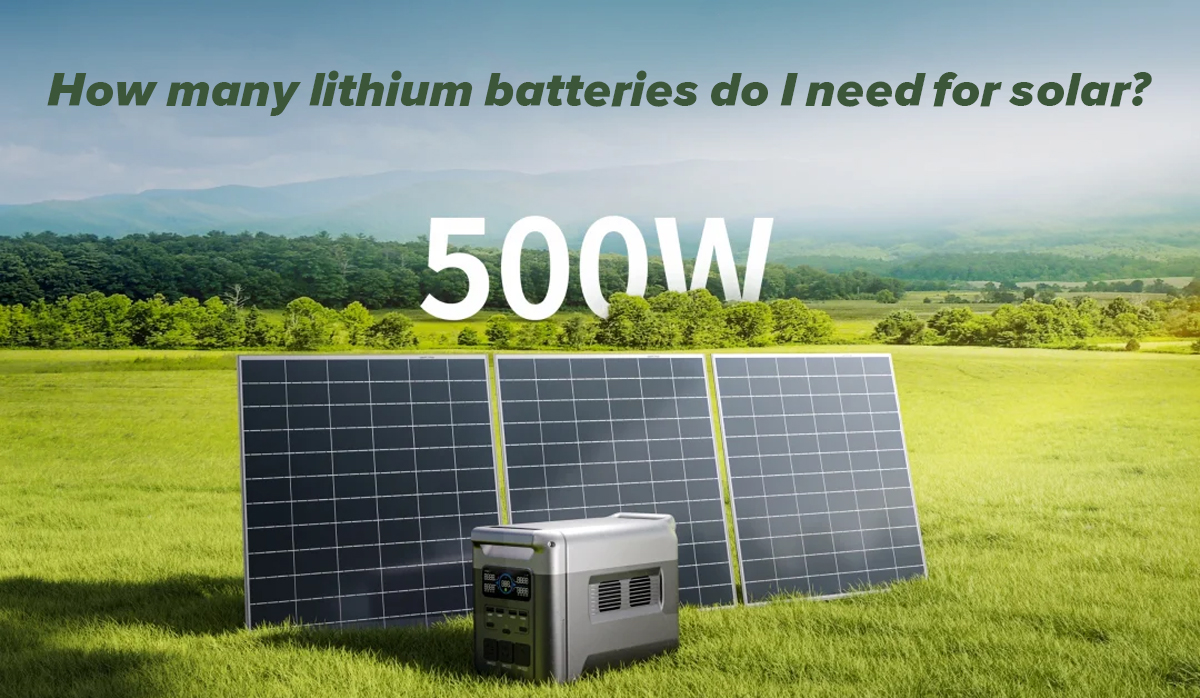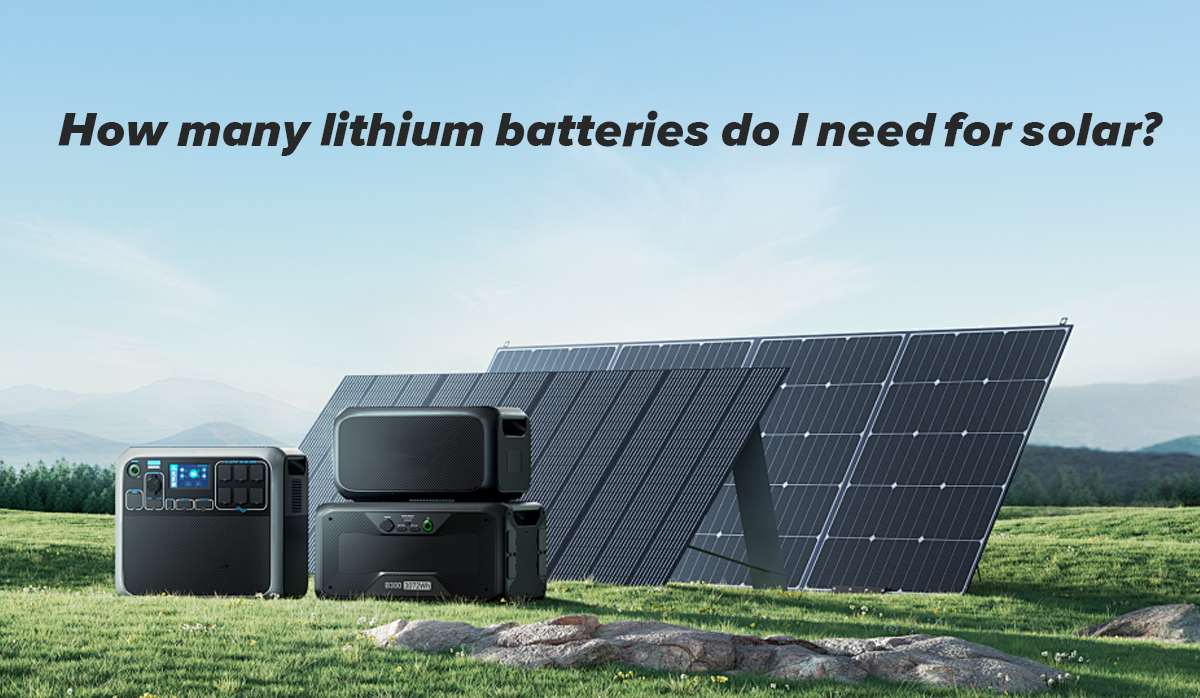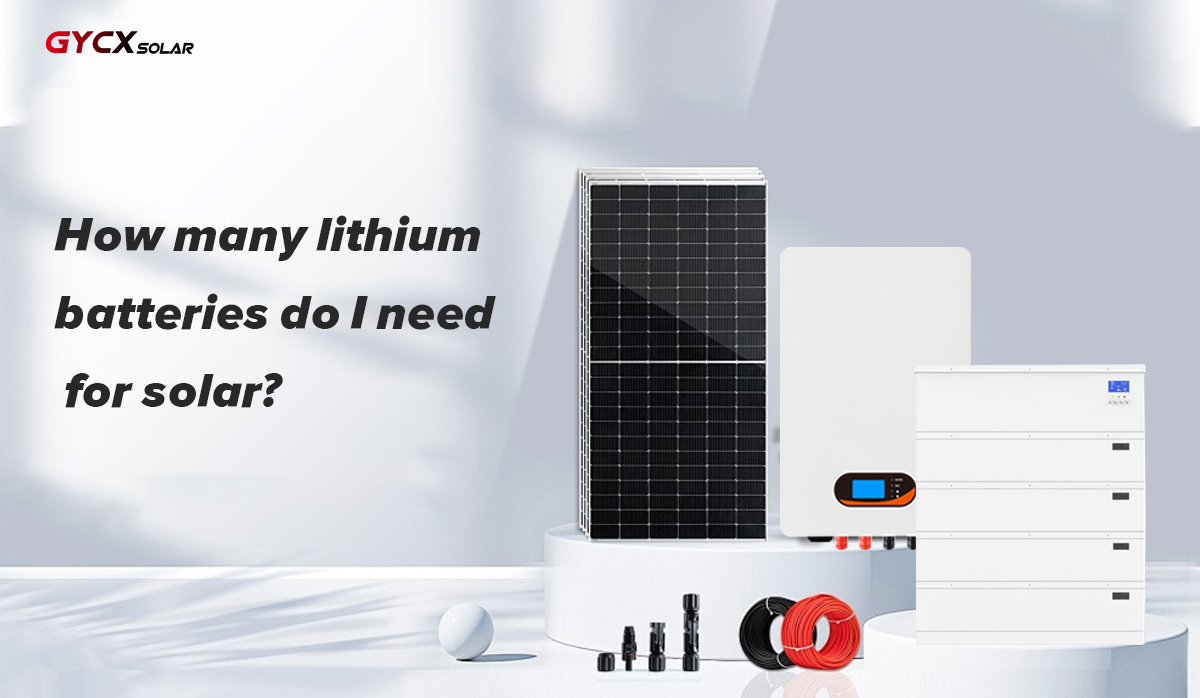1. Introduction

Solar energy is reshaping how we power our homes and businesses, and one of the most important aspects of a successful solar system is the lithium batteries storage that captures and distributes the energy. A common question for those planning a solar installation is, “How many lithium batteries do I need for solar?” In this article, we’ll break down the factors influencing battery sizing, discuss how to calculate the ideal number of lithium batteries for your system, and compare different types of lithium batteries available on the market.
Drawing on insights from industry experts and practical data, our guide is designed to help you make an informed decision for a reliable, efficient, and scalable solar energy solution.
2. Understanding Your Energy Needs
Before deciding on the number of batteries, you need to understand your daily energy consumption and system requirements. This includes:
- Daily kWh Usage: Review your utility bills to determine your average daily energy usage in kilowatt-hours (kWh). This figure sets the baseline for your storage needs.
- Peak Load Demands: Identify the times of day when your energy consumption is highest. Your battery bank must cover these peak periods.
- Backup vs. Off-Grid: Decide whether you want a system that provides backup power during outages or a fully off-grid system. Backup systems may require fewer batteries if they only need to cover critical loads.
This assessment is essential because an accurately sized battery bank ensures you get the most out of your solar panels without overspending on storage.
3. Key Factors in Battery Sizing
Several factors affect how many lithium batteries you’ll need for your solar system:
a. Battery Capacity
Lithium batteries come in various capacities (measured in kWh). For example, a battery rated at 10 kWh can theoretically store 10 kilowatt-hours of energy. Knowing the capacity of the batteries you’re considering is the first step in determining how many units are needed.
b. Depth of Discharge (DoD)
Depth of discharge is the percentage of the battery’s total capacity that can be safely used without shortening its lifespan. Most lithium batteries have a DoD of around 80%–90%. When planning your battery bank, you should factor in DoD to ensure you have sufficient usable capacity.
c. Efficiency and Losses
No system is perfectly efficient. Energy losses occur during charging and discharging. Accounting for these losses—typically in the range of 5%–10%—ensures your battery bank is robust enough to meet your daily demands.
d. Future Scalability
When sizing your system, consider future energy needs. If you expect an increase in consumption or plan to add more solar panels later, opting for a modular solution allows for easy expansion without a complete system overhaul.
4. Calculating How Many Batteries You Need

Let’s walk through a simplified example of how to calculate the number of lithium batteries required:
- Determine Daily Energy Usage:
Suppose your household uses 30 kWh of energy per day. - Decide on the Usable Capacity:
If you’re using a battery with a rated capacity of 10 kWh and an 80% DoD, the usable capacity per battery is:
10 kWh × 0.8 = 8 kWh. - Calculate the Number of Batteries:
To cover 30 kWh of daily usage, you’d need:
30 kWh ÷ 8 kWh per battery ≈ 3.75, which means you should round up to 4 batteries to ensure adequate storage. - Consider Efficiency Losses:
If your system has additional inefficiencies, you might want to add one extra battery as a buffer, bringing the total to 5 batteries.
This calculation is a baseline; your specific needs might vary based on your local conditions, future load increases, and system design.
5. Comparing Lithium Battery Options
Not all lithium batteries are created equal, and your choice will depend on both performance and practical considerations. Let’s look at some common types:
a. Stackable Lithium Battery
Stackable Lithium Battery systems offer modularity and scalability. They’re designed to be easily expanded, making them an excellent option for homeowners who want to start with a smaller system and add capacity over time. Their compact design ensures efficient use of space while providing reliable energy storage.
For more details on this product, check out our Stackable Lithium Battery page.
b. Solar Battery
The term Solar Battery generally refers to energy storage solutions specifically engineered for solar applications. These batteries are optimized for the charge-discharge cycles associated with solar energy and are designed for long-term performance. They come in various sizes and capacities to suit both residential and commercial applications.
Learn more about our range of Solar Batteries by visiting https://gycxsolar.com/product/solar-battery/.
c. Solar Inverter
While not a battery per se, the Solar Inverter is a crucial component that works hand in hand with your battery bank. It converts the direct current (DC) from your solar panels and batteries into alternating current (AC) for household use. A high-quality inverter maximizes efficiency and ensures that the energy stored in your batteries is readily usable.
Explore our Solar Inverter offerings.
Each of these product types plays an important role in creating a balanced and efficient solar energy system. When considering the number of lithium batteries you need, it’s vital to think about how these components interact and complement one another.
6. Integrating GYCX Solar Products

At GYCX Solar, our product line is designed to provide seamless integration for your solar energy system. By combining the strengths of each component, you can optimize performance and reliability. Here’s how our products come together:
- Modularity with the Stackable Lithium Battery:
The modular design means you can start small and scale your system as needed. This flexibility is ideal if you’re unsure about future energy needs or plan to expand your system over time. - Efficiency with the Solar Battery:
Our Solar Battery solutions are engineered for optimal performance, ensuring high efficiency and longevity even with frequent charge-discharge cycles. - Reliability with the Solar Inverter:
A reliable Solar Inverter is crucial for converting stored energy into usable power. Our range of inverters guarantees high conversion efficiency and robust performance under varying load conditions.
By carefully selecting and integrating these products, you’ll build a solar energy system that not only meets your current energy demands but also adapts to future needs.
7. Practical Tips for Optimized Performance
Beyond the basic calculation and product selection, there are additional strategies to optimize your solar battery system:
a. Regular Monitoring and Maintenance
- Monitor Performance:
Use energy management tools to track battery performance and ensure that your system is operating efficiently. - Schedule Maintenance:
Regular maintenance of batteries and inverters can extend the lifespan of your system and help identify potential issues early.
b. Consider Environmental Factors
- Temperature Effects:
Lithium batteries perform best within a specific temperature range. Ensure proper ventilation or climate control where your batteries are installed. - Installation Best Practices:
Follow manufacturer guidelines during installation to maximize performance and safety. Proper mounting and wiring are essential to avoid energy losses.
c. Future-Proofing Your System
- Plan for Expansion:
If you anticipate increased energy needs, design your system with scalability in mind. Modular products like the Stackable Lithium Battery offer an easy upgrade path. - Stay Updated on Technology:
Battery technology is constantly evolving. Keeping an eye on new developments may offer opportunities for even greater efficiency and cost savings in the future.
Implementing these strategies can help you make the most of your solar energy investment and ensure a smooth, efficient operation over time.
8. Conclusion
Deciding how many lithium batteries you need for your solar system isn’t a one-size-fits-all answer—it depends on your daily energy consumption, the capacity of the batteries you choose, and your long-term energy goals. By understanding your energy needs, calculating the required storage capacity, and comparing different lithium battery options, you can build a system that offers both reliability and scalability.
At GYCX Solar, we provide a range of products designed to meet these challenges head-on. Whether you opt for our Stackable Lithium Battery for modular expansion, our robust Solar Battery for efficient storage, or our reliable Solar Inverter for optimal power conversion, our solutions are engineered to work seamlessly together to maximize your solar energy system’s performance.
Empower your journey toward energy independence by carefully planning and integrating quality components. With the right strategy in place, you can achieve a cost-effective and highly efficient solar energy system that stands the test of time.
GycxSolar provides high-quality lithium battery products to customers worldwide. Welcome to your consultation.
